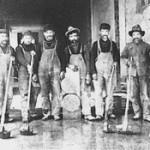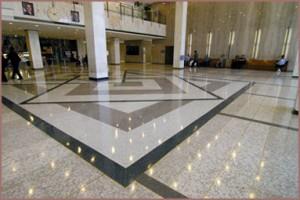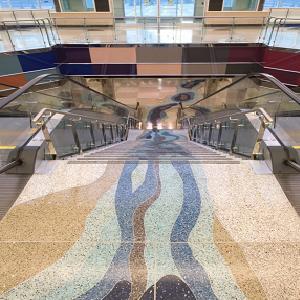

About Terrazzo:
 Terrazzo has been around for centuries. In its origins Terrazzo was simply marble chips mixed in with colored Portland Cement. The term “Terrazzo” actually is derived the Latin word “terra” which means earth, (I told you it has been around for a while). Typically the Romans used Terrazzo on their outside patios or “terraces”. The colored cement is called the “matrix”, not quite as high-tech as the movies, but as infinitely diverse and interesting as a design element. The matrix is what really brings the beauty of Terrazzo to the forefront.
Terrazzo has been around for centuries. In its origins Terrazzo was simply marble chips mixed in with colored Portland Cement. The term “Terrazzo” actually is derived the Latin word “terra” which means earth, (I told you it has been around for a while). Typically the Romans used Terrazzo on their outside patios or “terraces”. The colored cement is called the “matrix”, not quite as high-tech as the movies, but as infinitely diverse and interesting as a design element. The matrix is what really brings the beauty of Terrazzo to the forefront.
Let me take a moment here to explain how Terrazzo has traditionally been installed. First, it was poured out, then ground down flat and usually left at a 100-grit finish. At this point a topical Terrazzo sealer was applied, followed by multiple coats of floor wax or finish. This is a time-intensive process, as the floor requires constant buffing and re-waxing to maintain a high-luster shine.
This process has been modernized over time and today, we now have epoxy-based Terrazzo,
A bit easier to apply perhaps, but the restoration process is mostly the same, except that densification is not required (and I certainly don’t recommend it).
Since most Terrazzo has already been ground (sometimes as long as 100 years ago), contractors can generally start with 50 or 100 grit resins. In some instances where a floor is very wavy, you may have to start with a high metal diamond instead, but use caution if you drop to lower grit diamond!
It is important to keep in mind that unlike a concrete floor, a Terrazzo surface is generally only 3/8 to 1/2 inch thick. That means if you start to grind with a 50 metal, you could very easily reveal the underlying cement bed and with metal grits, you run the risk of exposing pinhole air pockets that will need to re-grouted with color-matched cement or epoxy maintain the original matrix. These concerns can be avoided if you start off with the resins and work your way in. However, be aware that some surfaces must be started with metals. Frequent floor stripping (using harsh and acidic chemicals) can really damage and “pit” the floor. This scenario surface will most certainly require an initial grind with a low grit metal. This is a pretty tricky craft and I would strongly urge that you consult with a Terrazzo restoration professional before you begin your grinding and restoration until you have sufficient experience to manage these nuances!
About Honing A Terrazzo Floor:
Getting the High Shine:
 My tool of choice at this stage of the process is a trusty 175-rpm floor buffer with a natural fiber floor pad underneath and I always have 135-150 lbs of weight total. I then sprinkle a marble polishing compound on the floor. I prefer to use the traditional Italian polishing compound called 5X, which is also polished wet. I simply make a few passes over the floor with this slurry and pick up the excess with a wet vac. It is worth pointing out that his area will probably need to be mopped with an alkaline cleaning solution to neutralize the acidic nature of the 5X, but what you will have now is a floor closer to an 1800 or 3000 grit shine. The 5X not only has abrasive qualities to smooth out the floor, but the acidic nature will also chemically polish the marble chips to an incredible shine. As an additional benefit, this method will also “pop” an unbelievable shine on an exposed aggregate concrete floor!
My tool of choice at this stage of the process is a trusty 175-rpm floor buffer with a natural fiber floor pad underneath and I always have 135-150 lbs of weight total. I then sprinkle a marble polishing compound on the floor. I prefer to use the traditional Italian polishing compound called 5X, which is also polished wet. I simply make a few passes over the floor with this slurry and pick up the excess with a wet vac. It is worth pointing out that his area will probably need to be mopped with an alkaline cleaning solution to neutralize the acidic nature of the 5X, but what you will have now is a floor closer to an 1800 or 3000 grit shine. The 5X not only has abrasive qualities to smooth out the floor, but the acidic nature will also chemically polish the marble chips to an incredible shine. As an additional benefit, this method will also “pop” an unbelievable shine on an exposed aggregate concrete floor! Depending on the project requirement and my bid, I sometimes employ an alternative method to get my “Gloss” on. I can polish the floor to 800 or 1800 then add a protective coat to the floor that will enhance the shine. My preferred process is to apply about 3 coats of Convergent’s PentraGuard or Prosoco’s LS Guard. I apply like a floor wax with a microfiber then burnish (2000rpms or more) with 1500 Twister Pad or a very stiff Gorilla floor pad. We have conducted tests on both Cementious and Epoxy Terrazzo in extremely high-traffic environments and the results were outstanding. The Facility Manager stated our test area maintained the shine, but also did not scuff up like the waxed areas.
Depending on the project requirement and my bid, I sometimes employ an alternative method to get my “Gloss” on. I can polish the floor to 800 or 1800 then add a protective coat to the floor that will enhance the shine. My preferred process is to apply about 3 coats of Convergent’s PentraGuard or Prosoco’s LS Guard. I apply like a floor wax with a microfiber then burnish (2000rpms or more) with 1500 Twister Pad or a very stiff Gorilla floor pad. We have conducted tests on both Cementious and Epoxy Terrazzo in extremely high-traffic environments and the results were outstanding. The Facility Manager stated our test area maintained the shine, but also did not scuff up like the waxed areas.